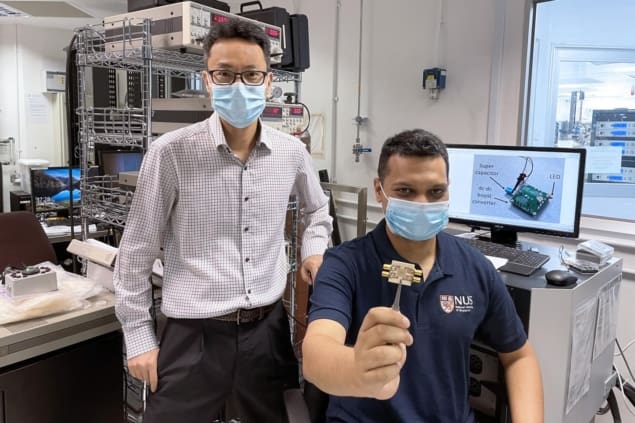WiFi signals used to power small electrical devices
02 Jun 2021
Ambient WiFi signals can be used to power small electrical devices such as LEDs, researchers in Singapore and Japan have shown. Hyunsoo Yang at the National University of Singapore and colleagues have developed a new way of connecting tiny microwave oscillators, allowing them to charge a capacitor that can then drive devices such as remote sensors. The research could also lead to the development of circuits that mimic the nervous system.
WiFi is ubiquitous in buildings and a growing number of public spaces, which are awash with 2.4 GHz microwaves used to exchange data. While this provides Internet access for the masses, large amounts of microwave energy goes to waste.
Yang’s team propose that this energy could be harvested to provide a wireless power source for small electrical devices, which would operate without any need for batteries. Their idea is based around emerging devices called spin-torque oscillators (STOs). These are nanoscale devices that can create and detect microwave signals and are compatible with commercial semiconductor manufacturing. Today, however, the usefulness of STOs is limited by their low power output and broadband nature.
Synchronized operation
These shortcomings can be overcome by synchronizing the outputs of multiple STOs. One way of doing this is to put the STOs microns apart, but this is unsuitable for efficient on-chip systems and does not work well for WiFi signals. Another possible solution is to couple the STOs using radio-frequency electrical signals, which is what Yang and colleagues have done.
When a configuration of eight STOs were connected in series, the team found that they could convert WiFi signals they received into a direct-current voltage that could charge a capacitor. They found that charging the capacitor for 5 s stored enough energy to power a 1.6-volt LED for 1 min.
The team also looked at how synchronization improved the STOs ability to broadcast gigahertz microwave signals and found that a parallel configuration is better suited for this application.
In future research, Yang’s team aim to upscale their energy harvesting techniques by increasing the numbers of STOs in their arrays, while also using them to charge other electrical devices and sensors. By working with industry partners, they hope to pave the way for every day, battery-free electronics, suitable for integration into networks of smart devices comprising the Internet of Things. Other possible applications for synchronized STOs include high-speed neuromorphic computing systems, which process information by mimicking biological nervous systems.
The research is described in Nature Communications.
FROM PHYSICSWORLD.COM 4/5/2021

Δεν υπάρχουν σχόλια:
Δημοσίευση σχολίου